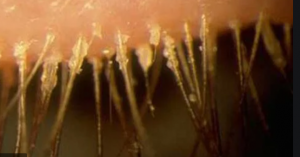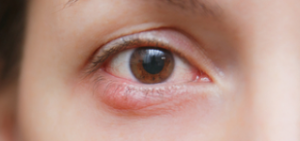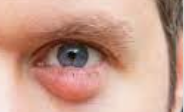What is a chalazion?
A chalazion is a lump that forms under the skin of the eyelid.
It can develop when the meibomian gland becomes obstructed or inflamed, causing a release of the gland’s contents into the surrounding soft tissue.
This in turn, leads to a lipogranulomatosis reaction, causing a lump to form. When the chalazion begins to develop, it may be tender to touch, though it typically evolves into a painless lump.
Chalazion or stye?
Very often, patients confuse these two eyelid conditions, as they can appear similar on the eyelid.
However, a chalazion and stye are two distinct eyelid conditions that require different methods of treatment.
A chalazion is a painless lump that develops from a clogged oil gland, while a stye is a painful lump that develops from an infected oil gland or eyelash follicle.
Occasionally, a chalazion can evolve into a stye if it becomes infected.
Risk factors
If you have had a chalazion in the past, your chances of developing another one are generally higher than those who have never had one before.
Certain eye and skin inflammatory conditions can cause a chalazion to develop. These include:
- Chronic blepharitis
- Seborrheic dermatitis
- Acne
- Rosacea
A chalazion can also be caused by:
- Viral infection
- Diabetes
- Skin cancer
- Tuberculosis
Though less common, a chalazion can also develop with viral conjunctivitis, an eye infection commonly known as pink eye.
Contact an eye doctor near you who has experience diagnosing and treating chalazions.
SEE RELATED: What is Chalazion?
How is a chalazion treated?
Chalazia will generally disappear on their own within a couple of weeks.
Avoid wearing contact lenses and makeup until your eyelid has completely healed to protect your eye from irritation and infection.
Home remedies
To help speed up the healing process, eye doctors recommend applying warm, wet compresses to your eyelid several times per day for 10 to 15 minutes, and gently massaging your eyelid for a few minutes each day. This can help to release clogged oil ducts and reduce inflammation and discomfort.
Important: Squeezing or popping a chalazion can significantly increase your risk of an eye infection. Avoid touching the inflamed area once the lump begins to drain to prevent bacteria and germs from entering the open wound.
Over-the-counter (OCT) relief
If you are searching for further relief, OTC eye drops, ointments, and medicated pads can help to reduce soreness and irritation and speed up the healing process. Ask your eye doctor which one he recommends for you.
Prescription medication
If the chalazion lingers for more than a few weeks and does not seem to be responding to OTC medication, schedule an appointment with your eye doctor.
In some cases, stronger medication is necessary to help reduce inflammation, speed up the healing process and relieve discomfort.
Your eye doctor can prescribe an anti-inflammatory eye drop or ointment, or may even recommend a steroid injection, depending on the size, location, and number of chalazia on your eyelid.
Oral antibiotics will be prescribed if the chalazion is infected.
Drainage
In severe cases, when a chalazion cannot be treated with medication, an in-office procedure to drain the inflamed fluid from the lump may be required. Antibiotics will then be prescribed to prevent a secondary infection and allow the eyelid to heal.
If chalazia become a chronic problem, contact an eye doctor, as they may wish to biopsy the lump to rule out any serious underlying conditions.
Prevention
Maintaining proper eyelid hygiene can help to prevent chalazia from developing.
Practice these eyelid hygiene tips on a daily basis:
- Cleanse your eyelids with a gentle eyelid scrub or baby shampoo to remove dirt and debris and prevent clogged oil glands.
- Avoid rubbing your eyes.
- Always wash your hands before touching your eyes.
- Wear sunglasses and protective eyewear to protect your eyes from dirt, dust, and other foreign particles.
- Replace eye makeup every six months to prevent contamination and infection.
LEARN MORE: Guide to Eye Conditions
While chalazia are generally not a cause for concern, if you notice a lump on your eyelid, it is always a good idea to schedule an appointment with an eye doctor.
Your eye doctor will determine if treatment is necessary and provide relief for uncomfortable symptoms.









